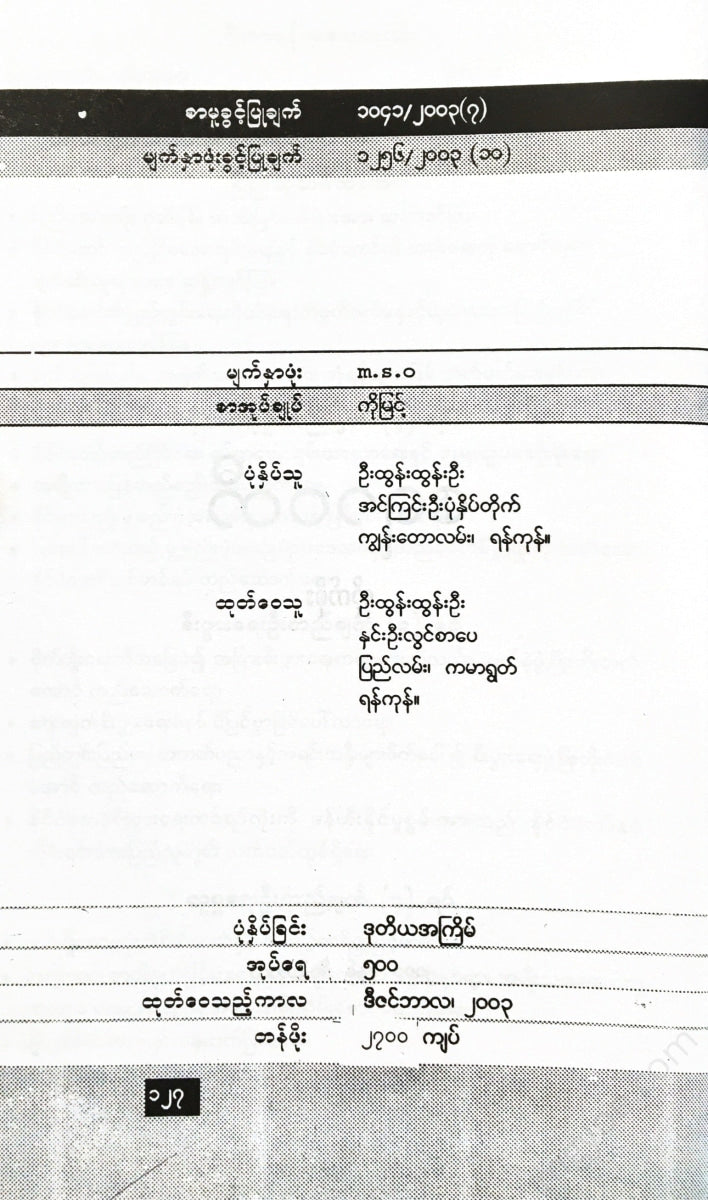စိတ်ကူးချိုချိုစာပေ
Tay Soe - The Irrawaddy
Tay Soe - The Irrawaddy
Couldn't load pickup availability
1. The beginning of the Irrawaddy
Kachin folk tales contain a theme of the structure of the universe.
The story goes that at first the universe was just a vast expanse of space. In that vast expanse, two elements, male and female, emerged. These two elements, when combined with each other, formed the Ingaung Vamagana.
From the body of that king of gods, three divine brothers, Maudalana, Maudalut, and Linyulav, were born. These divine brothers also created the sky, the sun, the moon, the oceans, the earth, inanimate trees, bamboos, flowers, and other living beings.
A long time passed. Then the king of gods, Ingaungwamagam, holding a golden cup in his right hand and a silver cup in his left hand, took a cup of water from the great ocean. Then he poured the water on the mountain peaks in the north, and from the right side, the Mekha River and from the left, the Malikha River emerged. The two rivers continued to flow until they met near the Chin Khranga region and became the Ayeyarwady River. The Ayeyarwady River passed through many places and flowed into the sea.
The king of gods took some of the ocean water with golden and silver cups and poured it back onto the earth repeatedly. Then, rivers, streams, and lakes formed on the earth.
The Ayeyarwady is the oldest river in the world. Therefore, it has unique characteristics compared to rivers in other regions.
The unique features are not only that gold dust and various kinds of fish can be found in the river, but also that the area where the Ayeyarwady flows is rich in trees and bamboos, and that crops grow abundantly. In addition, there is a large amount of valuable oil on the banks of the river. (1) -
This is the story of how the Ayeyarwady River was born, according to Kachin folklore.
2. To the first narrow river
A first-hand journey along the Ayeyarwady River will also begin in Kachin State.
The May Kha and Mali Kha rivers originate from the snow-capped mountains on the edge of Kachin State. The two rivers flow south and meet about twenty-eight miles above Myitkyina.
Myitsone is the beginning of the Ayeyarwady River.
The water is so cold. The clouds are so clear and calm. If you look down into the water, it is so clear that you can see big and small fish swimming around.
The river is about five hundred yards wide near Myitkyina. Along the shore are scattered pebbles. Kachin villagers who are fishing for gold are also seen smiling.
Here the cliff is quite steep. On top of it, lush green forests grow. In the distance, you can see the blue mountains.
The boat sailed along the river and crossed Tahonasha, forty-six miles from Myitkyina. Jade and//
To the west of the amber, you will come across a small stream flowing down from the Mogaung Taung mountain range and joining the Ayeyarwady. Along the riverbank, you will see Shan fishermen fishing in small boats.
The river is winding more and more. Near Manswar village, large rocks appear in the middle of the river. There are also many leeches.
But after Sinbo village, the water began to flow more slowly. The river narrowed. The narrower it became, the more the water gathered. The distance between the two banks was only about fifty yards. Then the rushing water hit the large rocks in front of it with great force, sending up spray. The roaring sound could be heard for a mile.
The rocky walls on either side of the river seemed to block the river as it rushed down. Sometimes, a mountain would appear directly in front of you. It seemed as if the river had completely disappeared. The boat, which was going down the river, would be about to hit the mountain when a small channel would appear on the right or left, and it would have to turn sharply in that direction.
The village of Thamgyi is located on the eastern bank of the Irrawaddy. Near the village, the narrow river widens to about eight hundred yards. The view is of the Shan and Palaung mountains, visible through the mist.
This is the first narrow stretch of the river, which is about thirty-six miles long. Near Bhamo, the Irrawaddy passes through an alluvial valley. The river is nearly two miles wide.

















